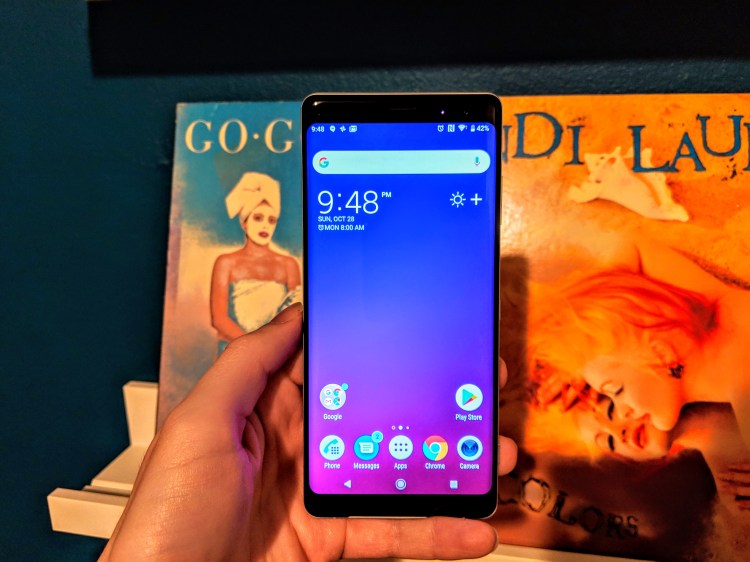Sony’s mobile division has seen rosier years, to put it diplomatically. In the quarter ending in July 2018, the company sold only 2 million handsets, and it took a $288 million write-down in Q4 2017, which it said would mark the start of “significant downsiz[ing].” (By comparison, Samsung shipped 9 million units.)
But Sony’s nothing if not determined.
At the IFA 2018 consumer electronics show in Berlin this year, the company took the wraps off the Xperia XZ3, the newest Xperia X series flagship. It’s the first in the Tokyo company’s portfolio with an OLED display and Side Sense, a custom drawer-like interface that’s triggered with a double tap of the phone’s left or right bezel. These two join carryover features from this spring’s Xperia XZ2, including dual stereo speakers, a rear-mounted fingerprint sensor, and a camera that’s capable of capturing 960 frames per second (fps) slow-motion video.
None of it comes cheap, though. The Xperia XZ3 costs $899 in the U.S. — on par with LG’s penta-lens LG V40, and $100 and $150 more than Google’s Pixel 3 and Apple’s iPhone XS, respectively. After spending a month with the thing, I’m not convinced it’s worth the premium price tag.
June 5th: The AI Audit in NYC
Join us next week in NYC to engage with top executive leaders, delving into strategies for auditing AI models to ensure fairness, optimal performance, and ethical compliance across diverse organizations. Secure your attendance for this exclusive invite-only event.
Design
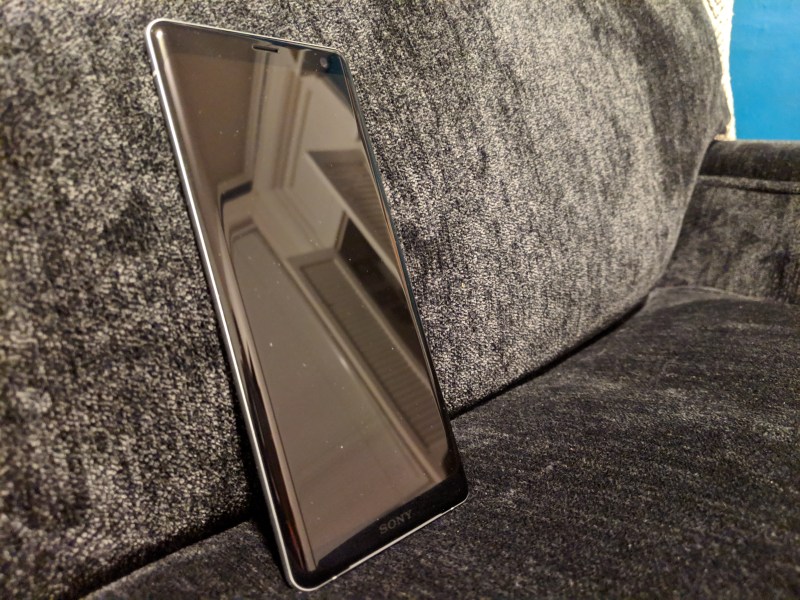
Above: The Sony Xperia XZ3 from the front.
In engineering the Xperia XZ2, Sony says it adhered to the principles of what it calls “Ambient Flow”: small screen bezels, gentle curves, and wraparound aluminum that blends seamlessly into the phone’s protective screen glass. It was a welcome change from the staid, overly geometric aesthetic that characterized OmniBalance, its previous design language, and I’m pleased to report that the Xperia XZ3 nudges the needle further in the right direction.
Front and center on the 6.2 x 2.9 x 0.39-inch, 193-gram XZ3 is the 6-inch, 1,440 x 2,880 pixel Triluminos OLED display, which has an 18:9 aspect ratio and a pixel density of about 537 pixels per inch (ppi). It slopes toward the rear cover on either side, but not as severely as the Samsung’s Galaxy Note9‘s curved display. It’s subtle, with narrow slivers of black frame on the left and right buffering the screen from the silver metal frame. In another nod to the Galaxy series and other smartphone flagships of the moment, the panel ditches corners for quadrants. There’s nary a straight edge in sight.
Its clean and streamlined aesthetic is somewhat sullied by bezels. Eschewing the notch trend, Sony’s opted for a more traditional display layout extending from the top earpiece and single 13-megapixel front-facing camera to the embossed logo near the bottom. Compared to the V40 and Pixel 3 XL, the bezels are distractingly thick and have the effect of making the screen appear smaller than it really is.
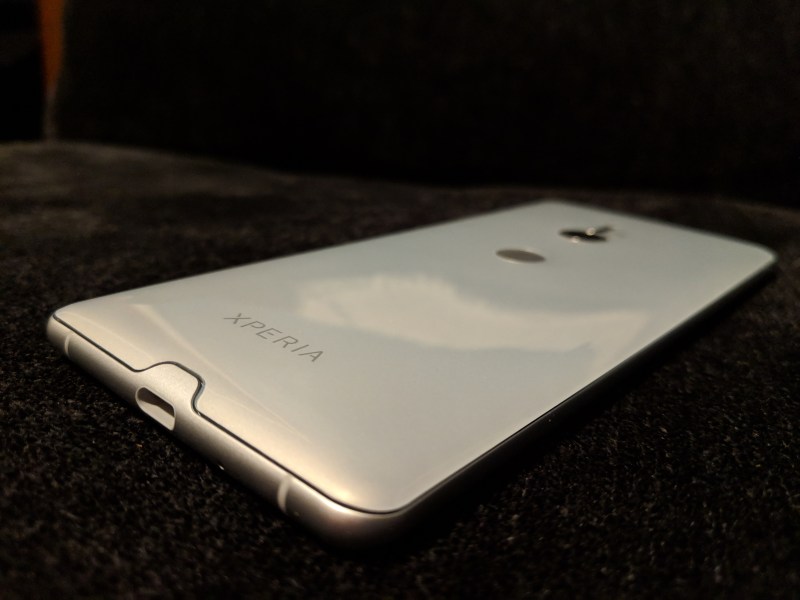
Above: The rear of the Sony Xperia XZ3.
There’s no notch or bezel to be found on the XZ3’s IP68 water- and dust-resistant flip side, which houses the 19-megapixel camera, LED flash, and laser autofocus. Beneath them is a fingerprint sensor and an Xperia decal etched into the 7000 series aluminum. I like the minimalist look, and the ergonomic Corning Gorilla Glass 5 topping the frame is both stylish and easy to grip, but the rear cover’s a debris magnet. My white silver model’s constantly plagued by pocket lint and fingerprints.
Rounding out the accoutrements is a power button, volume rocker, and dedicated camera button, the latter of which is a bit more wobbly than I’d like. On the bottom, there’s a USB-C port next to one of the XZ3’s two microphones, and on top a SIM card slot that doubles as a MicroSD card reader. (It’s conveniently recessed to allow for fingernail access.) In line with the XZ2, you won’t find a 3.5mm headphone jack onboard. Thankfully, there’s a USB-C-to-3.5mm adapter in the box.
Performance
So how does the XZ3 stand up in day-to-day use? Decently, I’d say.
The screen doesn’t get quite as bright as I’d like, much less come close to the 1,000-nit LG G7 we reviewed earlier this year. That said, I’m impressed with the default profile’s color accuracy. With adaptive brightness enabled and the color gamut and contrast set to “Standard mode,” it comes out ahead of the Pixel 3 (and just behind the LG V40) in my totally unscientific tests of dynamic range — the reds seem brighter, the blues and greens darker, and the blacks noticeably deeper. The same can’t be said of its color accuracy — compared to the V40, white backgrounds have a slightly warmer (pinkish?) hue; though I wouldn’t characterize it as distractingly bad.
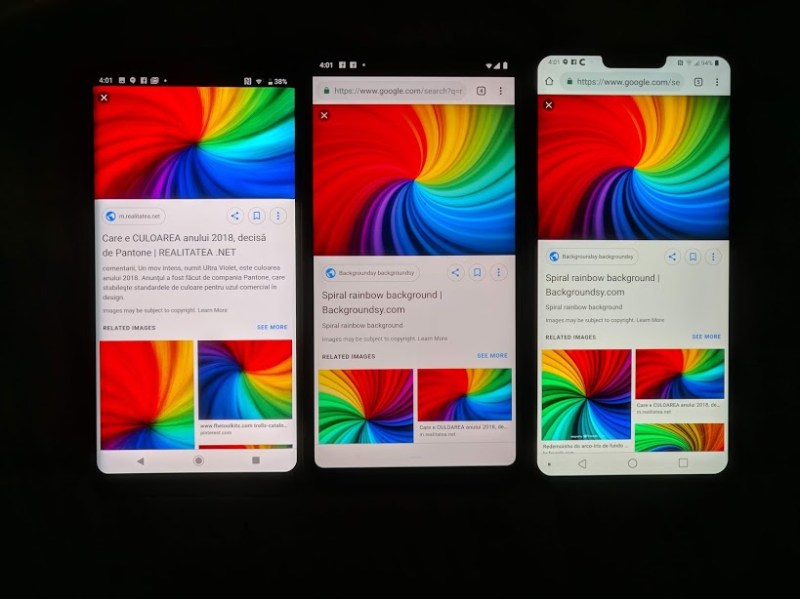
Above: From left to right: Sony Xperia XZ3, Pixel 3 XL, LG V40. All on default settings.
It’s plenty bright, too. I don’t have a luminance meter handy, but other outlets have pegged it at between 440 to 550 nits (one nit is equal to a candela, or the amount of light emitted by a common tallow candle per square meter). That’s competitive with the V40, which gets up to 600 nits, and the Pixel 3, which produces just over 400 nits.
And it’s pretty customizable. If Standard mode doesn’t strike your fancy, there’s Professional, which uses sRGB (the most widely used color space), and Super-vivid mode, which slightly oversaturates colors. On the white balance front, meanwhile, there are three predefined options on offer — Warm, Standard, and Cool – and per-color sliders for more granular control.
Predictably, high dynamic range (HDR) content — which boast wider color gamuts and better color contrast than its non-HDR counterparts — looks great on the XZ3. The screen is certified for HDR10, which covers 100 percent of DCI-P3 and Rec 2020 color spaces for a total of 1.07 billion colors (1024 shades of each primary color), but it lacks compatibility with Dolby’s eponymous Dolby Vision. In its place is Sony’s X-Reality engine, which automatically upscales video and manipulates contrast to HDR levels.
Directing our attention under the hood for a moment, the XZ3’s Qualcomm Snapdragon 845 system-on-chip is, as ever, no slouch — though it is worth mentioning that in the months since its February debut, it has been upstaged by chips like Apple’s A12 Bionic and Huawei’s Kirin 980. Still, the eight-core chip and the on-die Adreno 630 graphics drive a consistently smooth and stutter-free experience on the XZ3. Hitches are few and far between, even during informal stress testing (i.e., firing up a dozen or so apps in quick succession). And touch responsiveness — the lag time between a finger gesture and an onscreen response — isn’t noticeably worse than on the Pixel 3 XL, LG V40, or Xperia XZ2 (which also sports the Snapdragon 845).

It fares well in benchmark tests, too. In Geekbench 4, the XZ3 achieved an impressive multi-core score of 8,974, putting it ahead of not only the LG V40 (8,841), but the Vivo Nex S, Galaxy S9, Galaxy Note9, and LG G7.
All that power would go to waste without a long-lasting battery, of course. And while the XZ3 doesn’t rival title holders like the Vivo Nex, it’s in line with the competition. The 3,300mAh battery — slightly larger than the cell inside the XZ2 (3,180mAh) — lasts a solid day of light usage in my testing. If, like me, your routine consists of a mix of word processors (Google Docs, mostly), Chrome, YouTube, and a dab of Gmail thrown in for good measure, you’ll have no trouble making it from early morning to nighttime.
It can be stretched further by way of one of two power-saving modes: Stamina mode, which switches off background data, location (when the screen is off), video image enhancement, dynamic vibration, and ambient display; and Ultra Stamina mode, which disables internet connectivity and all but a handful of apps.
When the XZ3 eventually does run out of charge, it takes a while to juice up, unfortunately. While fast charging is present and accounted for, it lacks Qualcomm’s Quick Charge tech, instead relying on USB-PD. And in order to take advantage of that, you’ll have to pick up a third-party charger — the included wall adapter doesn’t support it.
Luckily, it’s a different story on the storage front. The XZ3 ships with 64GB (paired with 4GB or 6GB of RAM, depending on the region) that’s expandable up to 400GB via MicroSD card — on par with the G7, but half the internal storage in the base model Galaxy S9 and Galaxy Note9.
Camera and audio
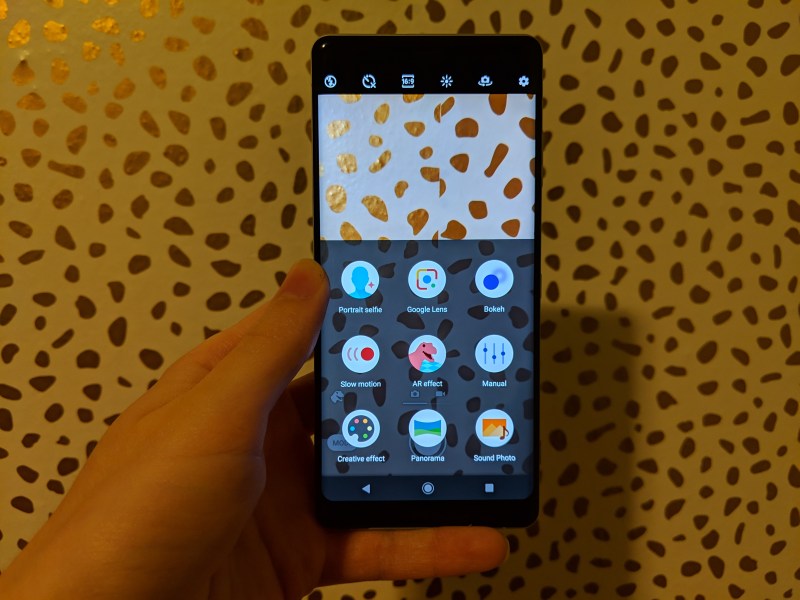
Above: The Sony Xperia XZ3’s camera app.
Sony has long used the Xperia series as something of a showcase for its top-end imaging sensors, and the XZ3 continues that tradition. Its 19-megapixel Exmor RS IMX400 Motion Eye sensor, first featured in the XZs and XZ Premium, has an f/2.0 aperture, a 1.22 µm pixel size, and a 25mm-wide G lens. At 1/2.3 inches, it’s one of the largest camera sensors in the industry, bigger than the iPhone XS’ rear sensor, and it’s one of the few that can shoot up to 960 fps at 1080p resolution (or 60 fps/30 fps at 1080p/4K).
It’s worth pointing out what’s not here, too. The XZ3 doesn’t have optical zoom to speak of, nor a portrait mode or optical image stabilization. And some of those omissions hold it back.
On the default mode with object tracking and lens correction disabled, the XZ3 takes sharp and bright — if somewhat flat — daytime photos, but dimly lit scenes give it trouble. Noise tends to creep in at the margins, and it overexposes light sources despite its improved Bionz processing algorithm, which Sony claims uses deep learning to adjust exposure automatically. It’s not as bad as, say, the LG V40, which produces atrociously grainy pics at night. But the overall quality is inferior to the Galaxy Note9 and Galaxy S9, and far behind the Pixel 3.
It’s an equally mixed bag on the video side of the equation. You’re stuck with less than a second of 960 fps slow motion at 1080p, and I found the three different slow-motion shooting schemes to be unnecessarily confusing.
So what about the selfie camera? Well, it’s a 13-megapixel, 1/3-inch sensor with an f/1.9 aperture, optical image stabilization, and a bokeh mode that blurs the background while keeping the foreground in focus. On the whole, it captures crisp, decently sharp photos that you wouldn’t be embarrassed to post on Instagram but which probably won’t win you any awards, either. I’m pleased to report that it doesn’t suffer from the same “pasty skin” problem as the LG V40, though — it resolves noticeably more detail, like cheek dimples and unshaven scruff.
I’d be remiss if I didn’t mention the myriad tools on tap in the XZ3’s camera app. In addition to portrait mode, which has adjustable “beauty” sliders that slim your cheeks and enlarge your eyes, there’s a bokeh mode that uses computer vision to approximate depth of field. Unfortunately, it’s super finicky — unless the camera’s exactly the right distance from the subject, you’ll get an error message.

Above: A portrait photo taken with the Sony Xperia XZ3.
There’s also object tracking, which didn’t work particularly consistently in my testing; an “auto capturing” feature that automatically snaps a pic when it detects a smile; filters like “mirror” and “old film”; Sound photo, which lets you attach an audio recording to a picture; a disappointingly laggy and stuttery augmented reality stickers mode akin to Google’s AR Stickers; and adjustable autofocus, shutter speed, ISO, exposure, and white balance settings.
Annoyingly, most of these aren’t integrated into the camera app proper; they exist as separate and distinct modules that can only be accessed from shortcuts within the app’s menu, which makes firing up features like portrait mode and Super slow motion a two-step process.
Stereo speakers
The XZ3, like the XZ2 before it, has stereo front-facing speakers — “S-Force Front Surround,” in Sony’s marketing parlance. They’re plenty loud (20 percent louder than the Xperia XZ2’s pair, to be exact), but high frequencies and speech become crackly at maximum volume. Moreover, compared to the Pixel 3, music sounds overly boomy and hollow, perhaps owing to the XZ3’s larger resonance chambers.
That said, bass heads will appreciate the XZ3’s Dynamic Vibration feature, which analyzes audio data and translates it into haptic motor whirs. It’s great for EDM and hip-hop tracks, but I found myself wishing there was a way to adjust it on a per-app basis; the slider that pops up onscreen when the volume rocker is used adjusts the intensity system-wide.
There’s no shortage of toggleable settings within the XZ3’s audio menu, including DSEE HX, which improves the quality of compressed music to “near Hi-Res Audio” with wired headphones; ClearAudio+, which “optimizes sound settings”; virtual surround sound; and Dynamic normalizer, which minimizes differences in volume between songs and videos. That’s in addition to Sony’s LDAC technology, which the company claims delivers an audio signal over Bluetooth up to 3 times standard quality.
Software

Above: The Sony Xperia Side Sense feature.
The XZ3 is the first in the Xperia series to ship with Android 9.0 Pie onboard, but it’s not a bone-stock experience. Sony’s aforementioned Xperia UI sits atop it and brings with it a custom home screen with an iOS-like horizontal app drawer, an Ambient display feature with clock styles and notification controls, and an Android 8.0-style multitasking menu.
Side Sense, one of the ostensible headliners, surfaces a menu with shortcuts to commonly used apps and settings through a double tap of the XZ3’s right or left bezel. (Think HTC’s Edge Sense or the Pixel 2 and 3’s Active Edge.) According to Sony, it’s informed by an artificial intelligence (AI) model that learns which apps you’re likely to use based on your location, the time of day and day of the week, and other signals. It’s nifty when it works, but frustrating when it activates accidentally (which isn’t a rare occurrence).
The XZ3’s AI features don’t stop there. Predictive Capture detects movement in front of the camera lens and buffers up to four images while you’re preparing to shoot. Smart launch automatically launches the camera when you hold the XZ3 in landscape as though you’re going to take a photo, and it works in tandem with Side Sense — double-tapping anywhere on the XZ3’s curved display edge triggers the shutter.

They join Battery Care, which purports to increase the battery lifespan by reducing the time the device is charged over 90 percent, and Smart Cleaner, which automatically optimizes storage and memory to “improve device performance.” Also in tow is Xperia Lounge, an advertisement platform for Sony’s music, gaming, and movie properties that occasionally bombards you with notifications, and first-party apps like the PlayStation app.
Xperia UI’s flourishes don’t bother me for the most part, but the amount of bloatware on display is overwhelming. At setup, I was prompted to install no fewer than 10 apps, including third-party apps like Booking.com, AVG Protection, and Amazon Shopping, Making matters worse, at least three of those apps — News Suite, Sketch, and Movie Creator — mimic the functionality of preinstalled Google apps (i.e., Google News and Google Photos).
I’m all for allowing Android original hardware manufacturers (OEMs) to customize their devices’ software — that’s their prerogative. But these customizations are without merit.
Conclusion
Sony’s timing is unfortunate. The Xperia XZ3 began shipping in earnest just after the LG V40 and weeks before Huawei’s Mate P20 Pro and the Pixel 3 and Pixel 3 XL. It’s a crowded market of able-bodied competitors, and most of them have the XZ3 beat at its current price point.
Sure, the XZ3’s camera is up there with the best of them, and the display is a wonder to behold, but those are the only standouts of note. The Pixel 3 takes better photos. The LG V40 snaps wide-angle selfies. And the Mate P20 Pro has a speedier processor.
It’s death by a thousand self-inflicted cuts, basically. The XZ3’s bezels are a bit too thick; Edge Sense doesn’t work consistently; and there’s far too much bloatware onboard. At $899, I’d expect more capable cameras and a revamped design, or at the very least a highly compelling software experience. But the XZ3 offers none of those.
